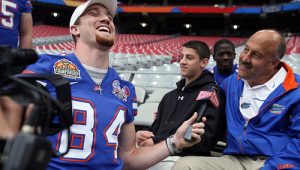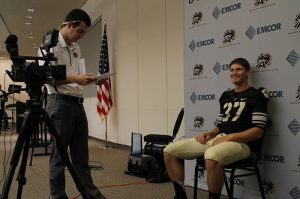 For an organization to win at its business strategies, media relations must be part of the game. Like any athlete, practice prepares clients for the interview. As the coach, Public Relations professionals need to deliver a thorough practice for the best results possible. Providing a successful media training session can be a challenge, but with the right setting and steps, both the client and media member can benefit.
For an organization to win at its business strategies, media relations must be part of the game. Like any athlete, practice prepares clients for the interview. As the coach, Public Relations professionals need to deliver a thorough practice for the best results possible. Providing a successful media training session can be a challenge, but with the right setting and steps, both the client and media member can benefit.
Perfect practice makes perfect
Like any sport, practicing correctly for media interviews is what will make your client a successful interviewer. How do you provide that perfect practice?
1. Be part of the home team
One of the first questions I ask when media training is how the individual or the group feels about the media. Many times the replies haven’t been so nice. Love them or hate them, your clients still need to interact with media members. Clients may have an “us versus them” attitude about the media, and the PR professional can get thrown into the “them” category. Help put your clients at ease by being understanding of their uneasiness; listen to why they feel the way they do about the media; explain the roles and objectives of the media and the spokesperson; and finally let your clients know you’re not there to make them love media but to help them understand the importance of interacting with media.
2. Bring your A game
Sometimes your media training can be basic and general in nature. Other times it will be complex and specific. Either way, be sure you bring your best to the table. If you’re giving an overall media training where you’re teaching clients about how to conduct a variety of media interviews, bring examples to show, be ready to answer questions, and provide take-away wallet cards after the session. If the training is specific to an upcoming interview, have the reporter’s bio and style ready to share with the client, provide facts about the topic, and coordinate a role play situation.
3. Scope out the competition
Think like the reporter. When prepping a client for a future interview, you should talk to the reporter beforehand and find out the topic. Though I never advise asking reporters for specific questions before the interview, you can get a sense of where the reporter is going with the story by asking how he is approaching it. Watch how the reporter has presented similar topics. Prepare questions that meet that angle, and then develop answers that address the questions plus incorporate your key messages. Also include information about any recent events that affect your client’s industry and prepare him for opinion questions that may come up in the interview.
4. Demonstrate the technique
Many people think a media interview is just about answering a reporter’s questions. If your clients are approaching the interview this way, you already know they are missing great opportunities to get vital information in front of their audiences. In my media trainings, I always give my clients this equation:
Perfect Response = Answer + Key Message
Use examples and show how a key message should be included. When I prepared Soldiers for deployments, I always gave the example every reporter asked at the farewell ceremonies:
Q: Are you ready to go?
A: Yes, my unit has been training for this deployment for the last several months through field exercises and drills, and we are prepared to complete the mission and return home safely.
Don’t let your clients off easy with softball questions; the reporter sure won’t. Practice the hard stuff. Teach your client the art of bridging to their key messages (Dan Broden has a particular memorable way to teach this technique using the Queensboro Bridge as a visual). Show them examples of some of the tricks of the trade reporters use to get around a spokesperson’s carefully-crafted messages. The more you prepare them for the worst, the better they will do.
6. Watch the clips
Athletes and coaches watch clips from previous performances to identify and understand where mistakes are made. The same should go for you and your client. It’s one thing to go through the questions and answers and see the key messages written out, but it’s quite another to allow clients to see themselves on video, with body language and tone of voice. I try to at least have clients see a short video of themselves responding, even if it’s just a mobile phone video, so they know what they will look like. Maybe they didn’t realize when a particularly negative question was being asked they were nodding their heads as if in agreement. Or maybe they never knew how much they use their hands when speaking. Video is good regardless of the format of the interview as it gives your client a visual of the real deal, but you may also consider doing voice recordings for upcoming radio interviews.
7. Keep locker room hours
As the coach, be available for follow-up questions. During the session, you’ve given a lot of information to take in, and it can be overwhelming for someone who has never interacted with the media before. If you sense your clients have follow-up questions or comments but may be shy about expressing them, you could encourage discussion by asking them what they think about a specific portion of the training. If it’s a group setting, you can make yourself available privately at the back of the room, which makes it more comfortable for people who would rather ask individually.
Practice makes all the difference in the game. Fans can tell when practice before a game wasn’t effective, and your client’s audience can tell when a media interview wasn’t prepared for. Provide a great media training session and your clients can deliver interviews that speak volumes to their target publics.
What else do you do to make sure your clients are ready for the big game?
photo credit: chasingfun via photopin cc
photo credit: West Point Public Affairs via photopin cc




